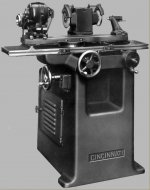
Is it possible to lock the X-axis on an old Cincinnatti #2 like this?
The handwheel (front left) is right at the operators hip and keeps getting nudged.
Besides, there's so much backlash you could jam the workholder into the wheel
like 0.05 by just leaning on it. This is not an actual picture of our machine but it
is close enough.
BTW is it normal for the direction of rotation to blast the dust up in the operator's face?
I tried reversing the motor
 and it worked great for a week, then the wheel came loose
and it worked great for a week, then the wheel came loose because I forgot to check the clamping nut was right-hand threaded! Fortunately it did not
blast the wheel in the operator's face.
We actually don't have any NC machines in out plant, 15 "automatic" screw machines
from the 1960s and presses from the '50s including a 1948 model SN 005. Hard to find
manuals!
I take that back, we have an old EDM and one of the Bridgeports has an actual DRO!

